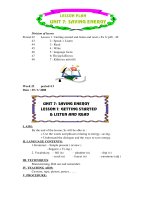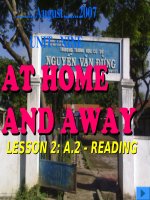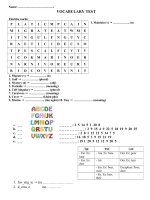Tài liệu unit nine
Bạn đang xem bản rút gọn của tài liệu. Xem và tải ngay bản đầy đủ của tài liệu tại đây (192.7 KB, 15 trang )
Date of teaching Class Absent students
12C1
Period 54
UNIT NINE : DESERTS
LESSON ONE : A – READING
A. Objectives
1. Aims: By the end of the lesson, Ss will be able to:
- Know the bad weather in the deserts and be interested in protecting the
environment.
- Understand the content of the passage, guess meaning from the context and
improve reading skill through true or false and answering question exercises.
2. Knowledge
- Vocabulary: Words and phrases related to deserts: typical features, how they
are formed, how animals and plants live.
- Grammar: simple present, simple past
3. Skill
- Main skill: reading
- Sub-skills: speaking and writing
B. Method: Integrated, Main Communicative
C. Teaching aids:
- Teacher: Sub - board, pictures.
- Students: Sub - boards.
D. Procedure:
Teacher’s activities Pupils’ activities
I. Warm up. (3’)
- Ask Ss to look at the picture and answer
the questions:
+ What can you see in the picture?
*. Chatting.
- Answer freely.
+ We can see a desert
+ We can see a camel.
II. Before you read. (10’)
- Ask Ss to work in pairs. Ask and
answer the questions.
- Give and explain the meaning of new
words.
* New words.
stretch [stret∫] (n)
- Work in pairs. Ask and answer the
questions freely.
+ There is no water in this place.
+ It is a hot, dry and sandy place.
+ This place has a arid climate......
- Listen carefully then copy down
aerial ['eəriəl] (adj)
hummock ['hʌmək] (n)
crest [krest] (n)
- Guide Ss to read new words.
- Give and explain the meaning of new
words.
- Guide Ss to read new words.
- Read new words in chorus.
- Read new words individually.
III. While you read. (20’)
- Let Ss have two minutes to read the
passage silently.
1. Activity 1: Task 1: Give the
Vietnamese equivalents to the following
words phrases.
- Ask Ss to work individually.
- Advise Ss to read the passage quickly
and stop at the lines that contain the
words to guess meaning from the
context.
- Go around the class and provide help if
necessary.
- Call on some Ss to read aloud their
answers. Ask them to explain their
choice.
- Give correct answers:
2. Activity 2: Task 2: Decide whether
the following statements are true (T) or
false (F).
- Have Ss read the passage more
carefully.
- Ask Ss to underline the information in
the passage that helps Ss find the correct
answers.
- Go around the class and provide help if
necessary.
- Ask Ss to compare with their partners.
- Call on some Ss to read and explain
their answers aloud in front of the class.
- Give feedback and correct answers:
3. Activity 3: Task 3: Answer the
questions according to the information in
- Read the passage about desert silently
- Listen carefully
- Individual work
- Read silently
- Give the Vietnamese equivalents to the
following words phrases.
1. Kéo dài, căng ra
2. Có cát,
3. Trắc lợng trên không
4. Hội địa lý hoàng gia Austra
5. Thổ dân Australia
6. Cồn cát, đụn cát
7. độ dốc, dốc thoai thoải
8. Dốc đứng, dốc ngợc
9. Gò, đống
10. Đỉnh
11. Cỏ lá nhỏ mọc trên xa mạc
- Read the passage more carefully and do
the task.
1. F, 2. F, 3. T,
4. F, 5. F, 6. T.
the passage.
- Have Ss work in pairs. Ask and answer
about the passage.
- Go around the class and provide help if
necessary.
- Call on some pairs to do the task in
front of the class.
- Give feedback and suggested answers.
- Pairs work
- Work in pairs. Ask and answer the
questions.
1. They are Great Victoria Deserts,
Gibbon….
2. It lies between Lake Eyre in the south,
the….
3. In 1845.
4. He was the President of the South….
5. They took camels across the desert.
6. In the western part, they are short,
mostly ….
7. Two. They are hummock grasses and
spinifex
IV. After you read. (10’)
* Read this story and answer the
questions that follow.
- Go around the class and provide help if
necessary.
- Call on some Ss to give answers in front
of the class.
- Explain.
- Control and correct.
V. Homework.
- Ask Ss to learn new words by heart,
summarize the main content of the
passages.
- Read this story and answer the questions
that follow.
1. Yes, it is.
2. The interpreter mispronounced the
word “ dessert”, and that made the
businessman misunderstood so the
businessman answer in a funny way “
Trees and water”
- Learn new words by heart and
summarize the main content of the
passages.
Date of teaching Class Absent students
12C1
Period 55
UNIT NINE : DESERTS
LESSON TWO: B - SPEAKING
A. Objectives
1. Aims: By the end of the lesson, Ss will be able to:
- Talk about natural features of deserts and desert life
- Discuss their ideas about related matters
- Know the bad weather in the deserts and be interested in protecting the
environment.
2. Knowledge
- Vocabulary: Words and phrases related to deserts
- Grammar: The tenses
3. Skill
- Main skill: speaking
- Sub-skills: listening and writing
B. Method: Integrated, Main Communicative
C. Teaching aids:
- Teacher: Textbook, handout
- Students: Sub - boards.
D. Procedure:
Teacher’s activities Students’ activities
* Warm-up: (5 minutes)
- Give some words and ask Ss to put them in
2 appropriate categories (animals and
plants): banana, horse, cactus, buffalo, grass,
crocodile, pine, rabbit
I. Pre-speaking : (12 minutes)
Task 1
- Explain the task and make sure that Ss
understand it.
- Instruct Ss to read through the words given
in the task.
- Explain some new words.
+ eucalyptus (n):
+ cactus (n):
+ date-palm
- Work in groups to do the task
Expected answers:
* Animals: horse, buffalo, crocodile,
rabbit
* Plants: banana, cactus, grass, pine
- Listen carefully
- Read silently
- Read after the teacher
- Have Ss work in pairs to discuss and do the
task.
- Walk around and help them.
- Call on some students to give their
answers.
- Provide feedback afterwards.
II. While-speaking : (16 minutes)
Task 2
- Explain the task carefully.
- Ask students to work in pairs to do the
task.
- Walk around observing and offering help
when necessary.
- Call some student to report their results
before the class.
- Ask for comments from other pairs.
- Give feedback afterwards.
III. Post-speaking : (10 minutes)
Task 3
- Explain the task to Ss carefully.
- Ask students to work in groups to do the
task.
- Call some representatives of the groups to
report their discussion.
- Correct their mistakes.
IV. Homework: (2 minutes)
- Ask the students to write a short paragraph
about the natural features of a desert.
- Work in pairs.
- Choose the animals or plants that
they think might exist in a desert and
then explain their choices.
- Take turns to express their ideas.
* Suggested ideas:
I think banana can’t exit in a desert
because it is a tropical plant but it is
very hot and dry in a desert …..
………
I think camels can live in deserts.
They can exist without food and water
for long if they need to. When they
eat, they store fat in their humps. They
can drink as much as 100 liters of
water...............
- Listen carefully
- Work in pairs to discuss and find out
as many natural features of a desert as
possible.
Suggested answers:
+ There is no water in a desert.
+ It is a hot, dry and sandy place.
+ There are very few animals and
plants living in a desert.
+ It has arid climate.
+ Very little rain falls in deserts
during the year.
…………
- Listen carefully
- Free practice
- Choose the five most important
things from the list given then explain
their choices.
Example: I think we should bring a lot
of food and water because there is no
water and food in a desert. Moreover,
they can help us to survive if we get
lost.
................
- Listen to the teacher.
- Write down the homework to do at home.
Date of teaching Class Absent students
12C1
Period 56
UNIT NINE : DESERTS
LESSON THREE: C - LISTENING
A. Objectives
1. Aims: By the end of the lesson, Ss will be able to:
- Improve listening skill through doing True or False exercise.
- Listen for specific information about the desert
- Know the bad weather in the deserts and be interested in protecting the
environment.
2. Knowledge
- Vocabulary: colony(n), cool (v), petroleum (n), Canal (n), needle (n),
firewood(n)
- Grammar: simple present
3. Skill
- Main skill: listening
- Sub-skills: speaking and writing
B. Method: Integrated, Main Communicative
C. Teaching aids:
- Teacher: tape, cassette player, projector and computer.
- Students: Sub - boards.
D. Procedure:
Teacher’s activities Pupils’ activities
I. Warm up. (3’)
- ASk Ss to observe 4 pictures on the
screen then answer the question
Where can you see real sand dune,
spinifex, camel and cactus?
- Introduce the topic of the lesson
“desert”
- observe 4 pictures on the screen then
answer the question
On desert
- Listen
II. Before you listen. (10’)
- Ask students to look at the screen and
answer the questions in the book.
- Let them work in pairs.
- Listen and correct their mistakes.
- Work in pairs.
- Look at the screen
- Listen to the teacher.
- Ask and answer the question in the
book.









